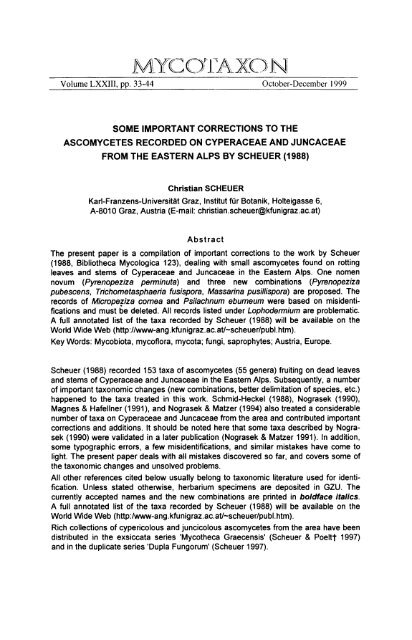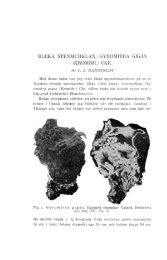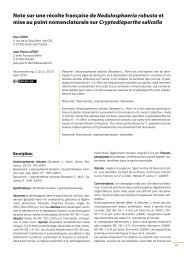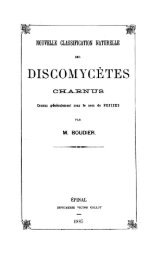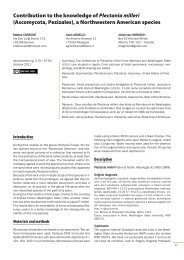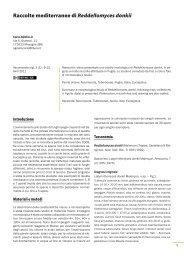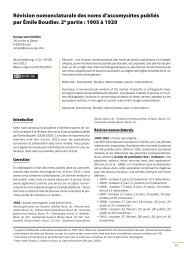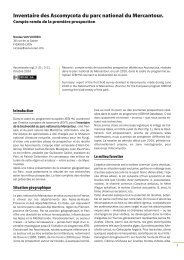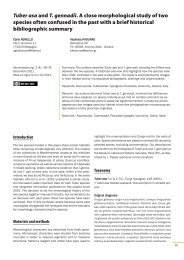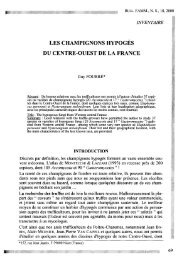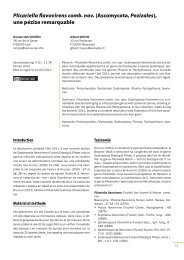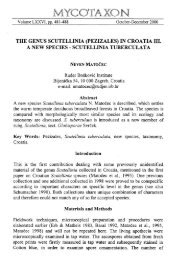some important corrections to the ascomycetes ... - Ascomycete.org
some important corrections to the ascomycetes ... - Ascomycete.org
some important corrections to the ascomycetes ... - Ascomycete.org
You also want an ePaper? Increase the reach of your titles
YUMPU automatically turns print PDFs into web optimized ePapers that Google loves.
Volume LXXIII, pp. 33-44 Oc<strong>to</strong>ber-December 1999<br />
SOME IMPORTANT CORRECTIONS TO THE<br />
ASCOMYCETES RECORDED ON CYPERACEAE AND JUNCACEAE<br />
FROM THE EASTERN ALPS BY SCHEUER (1988)<br />
Christian SCHEUER<br />
Karl-Franzens-Universitat Graz, Institut fOr Botanik, Holteigasse 6,<br />
A-8010 Graz, Austria (E-mail: christian.scheuer@kfunigraz.ac.at)<br />
Abstract<br />
The present paper is a compilation of <strong>important</strong> <strong>corrections</strong> <strong>to</strong> <strong>the</strong> work by Scheuer<br />
(1988, Biblio<strong>the</strong>ca Mycologica 123), dealing with small <strong>ascomycetes</strong> found on rotting<br />
leaves and stems of Cyperaceae and Juncaceae in <strong>the</strong> Eastern Alps. One nomen<br />
novum (Pyrenopeziza perminuta) and three new combinations (PyrenopezizB<br />
pubescens, Trichometasphaeria fusispora, Massarina pusillispora) are proposed. The<br />
records of Micropeziza cornea and Psilachnum ebumeum were based on misidentifications<br />
and must be deleted. All records listed under Lophodermium are problematic.<br />
A full annotated list of <strong>the</strong> taxa recorded by Scheuer (1988) will be available on <strong>the</strong><br />
World Wide Web (http://www-ang.kfunigraz.ac.at/-scheuer/publ.htm).<br />
Key Words: Mycobiota, mycoflora, mycota; fungi, saprophytes; Austria, Europe.<br />
Scheuer (1988) recorded 153 taxa of <strong>ascomycetes</strong> (55 genera) fruiting on dead leaves<br />
and stems of Cyperaceae and Juncaceae in <strong>the</strong> Eastern Alps. Subsequently, a number<br />
of <strong>important</strong> taxonomic changes (new combinations, better delimitation of species, etc.)<br />
happened <strong>to</strong> <strong>the</strong> taxa treated in this work. Schmid-Heckel (1988), Nograsek (1990),<br />
Magnes & Hafellner (1991), and Nograsek & Matzer (1994) also treated a considerable<br />
number of taxa on Cyperaceae and Juncaceae from <strong>the</strong> area and contributed <strong>important</strong><br />
<strong>corrections</strong> and additions. It should be noted here that <strong>some</strong> taxa described by Nograsek<br />
(1990) were validated in a later publication (Nograsek & Matzer 1991). In addition,<br />
<strong>some</strong> typographic errors, a few misidentifications, and similar mistakes have come <strong>to</strong><br />
light. The present paper deals with all mistakes discovered so far, and covers <strong>some</strong> of<br />
<strong>the</strong> taxonomic changes and unsolved problems.<br />
All o<strong>the</strong>r references cited below usually belong <strong>to</strong> taxonomic literature used for identification.<br />
Unless stated o<strong>the</strong>rwise, herbarium specimens are deposited in GZU. The<br />
currently accepted names and <strong>the</strong> new combinations are printed in boldface italics.<br />
A full annotated list of <strong>the</strong> taxa recorded by Scheuer (1988) will be available on <strong>the</strong><br />
World Wide Web (http:/www-ang.kfunigraz.ac.at/-scheuer/publ.htm).<br />
Rich collections of cypericolous and juncicolous <strong>ascomycetes</strong> from <strong>the</strong> area have been<br />
distributed in <strong>the</strong> exsiccata series 'Myco<strong>the</strong>ca Graecensis' (Scheuer & Poeltt 1997)<br />
and in <strong>the</strong> duplicate series 'Dupla Fungorum' (Scheuer 1997).
34<br />
• Brunnipila calycioides (Rehm) Baral in Baral & Krieglsteiner 1985. - Magnes<br />
& Hafellner (1991) found that <strong>the</strong> apical ring of <strong>the</strong> asci shows an IKt+ red (hemiamyloid)<br />
reaction, not IKI+ blue (euamyloid) as erroneously indicated by Scheuer<br />
(1988). However, H.O. Baral (pers. comm.) noted that at low IKt concentrations both<br />
<strong>the</strong> IKI+ red (rr type) and <strong>the</strong> IKI+ blue (rb type) reaction may occur (see BaraI1987).<br />
• Cistella hoehnelii Scheuer 1988 (as nomen novum)<br />
Bas.: Psilachnum granulosellum Hohnel1926<br />
(non Peziza granulosella P. Karsten 1869 == Cistella granulosella (P. Karst.)<br />
Nannf.)<br />
== Dasyscypha granulosella (Hohn.) Dennis 1949<br />
== Clavidisculum granulosellum (Hohn.) Raitviir 1970<br />
Syn.: Clavidisculum graminicola Raitviir 1969<br />
== Cistella graminicola (Raitv.) Raitviir 1978<br />
When Scheuer (1988) based his nomen novum on Hohnel's (1926) pro<strong>to</strong>logue of<br />
Psilachnum granulosellum and on <strong>the</strong> description and drawings provided by Dennis<br />
(1949), he was not aware of <strong>the</strong> paper by Raitviir (1978) who had already provided a<br />
new combination in Cistella for a later synonym of P. granulosellum, viz. Clavidisculum<br />
graminicola Raitviir, and listed P. granulosellum as a synonym of C. graminicola.<br />
Magnes & Hafellner (1991) and Nograsek & Matzer (1994) followed Raitviir (1978)<br />
instead of Scheuer (1988) and also named <strong>the</strong>ir collections C. graminicola. However,<br />
a taxon with a valid description and a satisfac<strong>to</strong>ry type specimen cannot be neglected.<br />
In <strong>the</strong> meantime, Hohnel's specimen of <strong>the</strong> type collection of P. granulosellum in FH<br />
was examined. It is designated here as <strong>the</strong> LECTOTYPE: 'Rehm: <strong>Ascomycete</strong>s exs.<br />
no. 1958. Urceolella chionea (Mass. et Cross!.) Rehm. An Blattern von Carex pendula.<br />
Pfalzau-Pressbaum im Wiener Wald, N.-Oesterreich. 4.1911, v. Keissler' (FH, Hohnel<br />
collection).<br />
• Clathrospora heterospora (De Not.) Wehmeyer var. heterospora; Wehmeyer<br />
1961, Shoemaker & Babcock 1992 as C. heterospora. - Scheuer (1988, Taf. 29,<br />
Fig. c) mentioned a collection on Juncus jacquinii L. (Austria, Salzburg, Hohe Tauern,<br />
Hafner-Gruppe, Oberer RotgOldensee, 2000 malt., 20.08.1981, leg. Ch. Scheuer) with<br />
extremely large ascospores ('70-90 x 32-44 x 15 IJm'). However, when a representative<br />
number of ascomata in this collection was re-examined, those large ascospores were<br />
not found again. Presumably <strong>the</strong>y had been studied during <strong>the</strong> process of swelling<br />
before germination.<br />
• Coronellaria caricinella (P. Karst.) P. Karst.; MOller & al. 1964, Baral in Baral &<br />
Krieglsteiner 1985. - One of <strong>the</strong> alpine collections (on Carex aterrima Hoppe, Austria,<br />
Steiermark, Gurktaler Alpen, Turrach, Dieslingsee, 2000 malt., 15.07.1930, leg. Genta)<br />
should be excluded from this species because <strong>the</strong> asci showed an IKI- apical<br />
apparatus when <strong>the</strong>y were re-examined, just like <strong>the</strong> 'Coronellaria cf. caricinella'treated<br />
by Nograsek & Matzer (1994). These IKI- collections probably belong <strong>to</strong> Hysteronaevia<br />
ra<strong>the</strong>r than Coronellaria. They are possibly conspecific with Hysteronaevia fimbriata<br />
Dennis & Spooner (1993).<br />
• 'Didymella' caricis H. Sydow 1921; Spooner & Dennis 1986. - See also below<br />
under 'Wettsteinina cf. niess/ii'. It must be noted here that two altitudes are given for<br />
one of <strong>the</strong> collections (on Carex pendula Huds., Austria, Oberosterreich, Schwarzberg<br />
S [of] Steyr, 21.04.1984, leg. Ch. Scheuer); 750 m is <strong>the</strong> correct altitude for this locality.
36<br />
1991). This is probably an aggregate of small <strong>to</strong> minute members of <strong>the</strong> Pyrenopeziza<br />
karstenii group, all keying out under Hysteropeziza pusilla at <strong>the</strong> moment.<br />
For <strong>the</strong> same reasons as in H. pubescens, a new combination seems appropriate, but<br />
because of <strong>the</strong> earlier Pyrenopeziza pusilla Saccardo & Spegazzini (in Saccardo 1878,<br />
Michelia 1: 423) a nomen novum is necessary:<br />
Pyrenopeziza perminuta Scheuer nom. novo<br />
Bas.: Hysteropeziza pusilla Hein & Scheuer 1986, Sydowia 38: 134.<br />
• Keissleriella fusispora Scheuer 1988. - Barr (1987, 1990, 1992) found that <strong>the</strong><br />
type species of <strong>the</strong> genus Keissleriella HOhn. belongs in <strong>the</strong> Melanommatales<br />
(Melanommataceae) and suggested <strong>to</strong> accommodate a number of former Keissleriella<br />
species in <strong>the</strong> genus Trichometasphaeria Munk (Pleosporales, Massarinaceae<br />
Lophios<strong>to</strong>mataceae). Therefore <strong>the</strong> following new combination is proposed:<br />
Trichometasphaeria fusispora (Scheuer) Scheuer comb. novo<br />
Bas.: Keissleriella fusispora Scheuer 1988, Biblioth. Mycol. 123: 86.<br />
A typographic error occurred in <strong>the</strong> Latin diagnosis of <strong>the</strong> pro<strong>to</strong>logue. The corrected<br />
passage reads as follows:<br />
Sporae ... symmetricae, primum l-septatae ...<br />
• Lachnum callimorphum (P. Karst.) P. Karst.; Dennis 1949 as Dasyscypha<br />
callimorpha, Raitviir 1970 as Dasyscyphus callimorphus, Dennis 1980 under Dasyscyphus<br />
imbecillis. - The two collections with longer-stalked ascomata on Carex<br />
sempervirens Viii. mentioned by Scheuer (1988) are conspecific with <strong>the</strong> collections on<br />
Carex erice<strong>to</strong>rum Pollich (confirm. H.O. Baral).<br />
• Lachnum e/ongatisporum Baral in Raitviir & Sacconi 1991 (as nom. prov. in<br />
Baral & Krieglsteiner 1985); Dennis 1949 as Dasyscypha cameola var. longispora.<br />
• Lachnum imbecille P. Karst.; Dennis 1980 as Dasyscyphus imbecillis, Schmid<br />
Heckel 1988 as Dasyscyphus imbecillis. - It remains open <strong>to</strong> doubt whe<strong>the</strong>r <strong>the</strong><br />
collections by Scheuer (1988) and Magnes & Hafellner (1991) are really conspecific<br />
with <strong>the</strong> type of Lachnum imbecille (H.D. Baral, pers. comm.; Dennis 1980).<br />
• Lep<strong>to</strong>sphaeria caricis-firmae: see under Phaeosphaeria C.<br />
• Lophodermium Juncinum (Jaap) Terrier in MOller 1977 (sensu Terrier), on<br />
Juncus trifidus L., Austria, Salzburg, Radstadter Tauern, Esser Aim unterhalb vom<br />
Mosermandl [Mosermannl], 2100 malt., 24.07.1982, leg. Ch. Scheuer. - This specimen<br />
was misidentified by Scheuer (1988) as 'Rhytisma' juncicola (see below), and redetermined<br />
by P.R. Johns<strong>to</strong>n (Auckland, 1996).<br />
• Lophodermium luzulae Hazsl. - The ascomata in <strong>the</strong> collection from Switzerland<br />
listed by Scheuer (1988) were apparently immature and not identifiable (vid. P.R.<br />
Johns<strong>to</strong>n, Auckland, 1996); see also annotations <strong>to</strong> 'Rhytisma' juncicola below.<br />
• 'Rhytisma' juncicola Rehm; Rehm '1896'. - Except for <strong>the</strong> single specimen redetermined<br />
as Lophodermium juncinum sensu Terrier by P.R. Johns<strong>to</strong>n (see above), all<br />
o<strong>the</strong>r identifications listed under Lophodermium juncinum, L. luzulae and 'Rhytisma'<br />
juncicola by Scheuer (1988) are uncertain. However, it should be noted here that<br />
Lophodermium luzulae and 'Rhytisma' juncicola agree in <strong>the</strong> structure of <strong>the</strong> ascoma<br />
wall. Coccomyces coronatus (Schum. ex Fr.) De Not., a species on leaves of deciduous<br />
trees, has <strong>the</strong> same wall structure (annot. P.R. Johns<strong>to</strong>n, Auckland, 1996).<br />
• Massariosphaeria grandispora (Sacc.) Leuchtmann 1984; MOller 1950 as Lep<strong>to</strong>sphaeria<br />
g., Holm & Holm 1988. - Although <strong>the</strong> laterally compressed ostiole is often
lacking in smaller ascomata, <strong>the</strong> most convenient current name appears <strong>to</strong> be Lophiotrema<br />
grandisporum (Sacc.) Shoemaker & Babcock (1989).<br />
• Massariosphaeria pusillispora Scheuer 1988. - The different concept for <strong>the</strong><br />
genus Massariosphaeria (E. Muller) Crivelli suggested by Barr (1989, as Chae<strong>to</strong>mastia<br />
(Sacc.) Berl.) also excludes M. pusillispora. Scheuer (1991 a) accommodated a very<br />
similar species in <strong>the</strong> genus Massarina Sacc. (Massarinaceae = Lophios<strong>to</strong>mataceae),<br />
M. tetraploa Scheuer. According <strong>to</strong> a revision of Massarina by Aptroot (1998), M. tetraploa<br />
was not combined in<strong>to</strong> ano<strong>the</strong>r genus. Therefore <strong>the</strong> following new combination is<br />
suggested:<br />
Massarina pusi/lispora (Scheuer) Scheuer comb. novo<br />
Bas.: Massariosphaeria pusi/lispora Scheuer 1988, Biblioth. Mycol. 123: 100.<br />
• Micropeziza cornea (Berk. & Broome) Nannfeldt 1976. - H.O. Baral (pers.<br />
comm.) has re-identified one of Scheuer's (1988) collections as 'Hymenoscyphus'<br />
salmanovicensis Svrcek (1978). All o<strong>the</strong>r collections recorded by Scheuer (1988) are<br />
conspecific. In addition, it must be noted here that this fungus has apparently nothing <strong>to</strong><br />
do with Trochi/a ignobilis P. Karst., a synonym of <strong>the</strong> real Micropeziza cornea (Nannfeldt<br />
1976).<br />
• Monascostroma innumerosum (Desm.) Hohn.; Munk 1957, Muller & Arx 1962.<br />
- Apparently <strong>the</strong> <strong>some</strong>what longitudinal arrangement of <strong>the</strong> finely verruculose<br />
ascospore wall ornament figured by Scheuer (1988) is not a regular feature of <strong>the</strong><br />
ascospore wall surface.<br />
• ?Montagnula spec. indet. - Scheuer (1988) described and figured <strong>the</strong> coarsely<br />
ornamented, dark brown, almost opaque ascospore walls and suggested that this<br />
fungus might be a relative of Montagnula opaca (Wegelin) Crivelli with smaller,<br />
'reduced' ascomata. It should be noted here that Nograsek (1990) did not follow this<br />
suggestion and placed two very similar species in <strong>the</strong> genus Phaeosphaeria Miyake,<br />
viz. Ph. glebosoverrucosa Nograsek and Ph. nanosalicium Nograsek. Lep<strong>to</strong>sphaeria<br />
kochiana E. Muller (1951) is most probably ano<strong>the</strong>r species of this group (E. Muller,<br />
pers. comm.).<br />
• Mycosphaerella hypos<strong>to</strong>matica Hohn.; Tomilin 1979 (erroneously as M. hypostromatica).<br />
- Type material should be compared with Scheuer's (1988) collections <strong>to</strong><br />
assess <strong>the</strong> conspecificity.<br />
• Naeviella paradoxa (Rehm) Clem.; Defago 1968 as Eupropolella p., Nannfeldt<br />
1982. - Scheuer (1988, as 'Naeviella aff. paradoxa1 also recorded a very similar<br />
fungus with slightly shorter ascospores discovered in two collections on Elyna myosuroides<br />
(Viii.) Fritsch. Asci and ascospores from both collections on this host were<br />
figured by Scheuer (1988, Taf. 5, Fig. b and c). Unfortunately, Fig. c was erroneously<br />
labelled Naeviella volkartiana. It shows 'Naeviella aft. paradoxa' on Elyna myosuroides.<br />
• Naeviella poeltiana Scheuer 1988. - This is turning out <strong>to</strong> be a problematic<br />
taxon because of <strong>the</strong> apparent differences in <strong>the</strong> intensity of <strong>the</strong> hemiamyloid (IKI+ red)<br />
reaction of <strong>the</strong> apical ring between different collections. According <strong>to</strong> Nograsek &<br />
Matzer (1994), <strong>the</strong> asci in <strong>the</strong>ir collections of N. poeltiana on Carex firma Mygind show<br />
an IKI- apical ring. On <strong>the</strong> o<strong>the</strong>r hand, a collection on Luzula alpino-pilosa (Chaix)<br />
Breistr. showed a much more intense IKI+ red reaction than <strong>the</strong> type on Carex<br />
ferruginea Scop. (erroneously <strong>the</strong> iodine reaction of <strong>the</strong> collection on Luzula alpinopi/osa<br />
was cited as IKI+ blue by Nograsek & Matzer 1994).<br />
37
38<br />
• 'Lep<strong>to</strong>sphaeria' caricis-firmae Petrak 1947; present name: Phaeosphaeria<br />
caricis-firmae (Petr.) Leuchtmann & Schmid-Heckel in Schmid-Heckel 1988. <br />
Apparently <strong>the</strong> new combination and re-description of Petrak's species were published<br />
a bit <strong>to</strong>o late <strong>to</strong> be included in <strong>the</strong> monograph by Shoemaker & Babcock (1989). These<br />
authors described a very similar taxon, Ph. exarata Shoemaker & Babcock, found on<br />
Carex sempervirens ViiI. in Switzerland. According <strong>to</strong> <strong>the</strong>ir description and illustrations,<br />
it is most probably conspecific with Ph. caricis-firmae.<br />
Nograsek (1990) pointed out two differences between our material (mainly on Carex<br />
firma Mygind, one collection on Carex atrata L.) and Petrak's pro<strong>to</strong>logue. Firstly, Petrak<br />
emphasized <strong>the</strong> parasitic lifestyle of <strong>the</strong> fungus, which should grow mainly on dead leaf<br />
tips, causing a dieback downward <strong>to</strong> <strong>the</strong> leaf base. Secondly, Petrak did not mention<br />
<strong>the</strong> characteristic longitudinally striate ornamentation of <strong>the</strong> ascospore wall. However,<br />
<strong>the</strong> type specimen in W shows that well-developed ascomata can also be found on<br />
dead (but still undecayed) leaves and that mature ascospores are uniformly striate.<br />
• 'Phaeosphaeria eus<strong>to</strong>ma (Fuckel) L. Holm 1957 sensu la<strong>to</strong>'. - Both collections<br />
described under this name by Scheuer (1988) do not belong <strong>to</strong> Ph. eus<strong>to</strong>ma s.str. as<br />
delimited in <strong>the</strong> revision by Shoemaker & Babcock (1989). The taxonomic positions of<br />
Scheuer's 'Phaeosphaeria eus<strong>to</strong>ma I' and 'Phaeosphaeria eus<strong>to</strong>ma 11' (both on Juncus<br />
effusus L.) remain unclear. It should be noted here that <strong>the</strong>y apparently belong in two<br />
different subgenera described by Shoemaker & Babcock (1989): 'Phaeosphaeria<br />
eus<strong>to</strong>ma I' would key out in subgen. Phaeosphaeria (probably close <strong>to</strong> Phaeosphaeria<br />
eus<strong>to</strong>ma s.str.), 'Phaeosphaeria eus<strong>to</strong>ma 11' resembles Phaeosphaeria moravica<br />
Shoemaker & Babcock (1989) and Phaeosphaeria juncinella (Mou<strong>to</strong>n) Shoemaker &<br />
Babcock (1989) in subgen. Fusispora. On <strong>the</strong> o<strong>the</strong>r hand, <strong>the</strong> collections published by<br />
Magnes & Hafellner (1991, on Equisetum f1uviati/e L. and Carex rostrata S<strong>to</strong>kes ex<br />
With.) are apparently conspecific with Phaeosphaeria eus<strong>to</strong>ma s.str.<br />
• Phaeosphaeria herpotrichoides (De Not.) L. Holm 1957 sensu la<strong>to</strong>. - Shoemaker<br />
& Babcock (1989) split up <strong>the</strong> former collective species Ph. herpotrichoides. The<br />
three collections tentatively identified by Scheuer (1988) as Eriksson's (1967) 'form 5a'<br />
and 'form 5b', can now be accommodated in Phaeosphaeria erikssonii Shoemaker &<br />
Babcock (1989). However, <strong>the</strong> asci and ascospores of <strong>the</strong> collection on Carex /eporina<br />
L. are larger than in typical Ph. erikssonii and often show an additional septum in <strong>the</strong><br />
lower hemispore.<br />
The species in Scheuer's unilocal lowland collections on Carex e/ata AIL, C. vesicaria<br />
L. and Scirpus radicans Schkuhr could not be assigned <strong>to</strong> any of Eriksson's (1967)<br />
'forms', nor <strong>to</strong> any of Shoemaker & Babcock's (1989) taxa (Scheuer 1988, Taf. 27,<br />
Fig. f).<br />
• Phaeosphaeria juncicola (Rehm) L. Holm 1957; Leuchtmann 1984, Schmid<br />
Heckel 1988, Shoemaker & Babcock 1989. - The isotype specimen of Ph. juncico/a in<br />
GZU (Rehm: <strong>Ascomycete</strong>s exs. no. 533, as Lep<strong>to</strong>sphaeria juncico/a) agrees with <strong>the</strong><br />
description of Holm (1957) or Leuchtmann (1984) who gave ascospore measurements<br />
of 30-46 x 4-4.5 IJm. The ascospores from <strong>the</strong> isotype in FH figured by Shoemaker &<br />
Babcock (1989) are apparently shorter and slightly broader, 30-35 x 4.5-5.5 IJm, just<br />
like in <strong>the</strong> original drawing by Rehm preserved with <strong>the</strong> type specimen in S. However,<br />
when <strong>the</strong> type specimen from S was examined, it was found that part of <strong>the</strong> ascomata<br />
in <strong>the</strong> type collection are slightly immature and that <strong>the</strong> ascospores drawn by<br />
Shoemaker & Babcock (1989) and Rehm apparently represent <strong>the</strong> lower range of<br />
variation.
• Phaeosphaeria juncina (Auersw. ap. Rabenh.) L. Holm 1957. - Shoemaker &<br />
Babcock (1989) examined type material of this species and found that <strong>the</strong> ascospores<br />
have longitudinally striate walls and are also much smaller than in <strong>the</strong> species treated<br />
under <strong>the</strong> name Ph. juncina by Holm (1957), Hedjaroude (1969), Leuchtmann (1984),<br />
and Scheuer (1988). Shoemaker & Babcock (1989) re-separated all taxa synonymized<br />
by <strong>the</strong>se authors under Ph. juncina. Now SCheuer's (1988) collections key out under<br />
Phaeosphaeria petkovicensis (Bub. & Ranoj. in Ranoj.) Shoemaker & Babcock<br />
(1989).<br />
• Phoma<strong>to</strong>spora berke/eyi Sacc. sensu la<strong>to</strong>; Arx & Muller 1954, Webster 1955,<br />
Nograsek 1990, Magnes & Hafellner 1991. - The small-spored Phoma<strong>to</strong>spora species<br />
usually identified as Ph. berke/eyi are in need of revision. The presence or absence of<br />
gelatinous coats or terminal appendages of <strong>the</strong> ascospore wall may provide <strong>some</strong><br />
useful morphological characters, but ascospore proportions may also be <strong>important</strong>. For<br />
example, <strong>the</strong> fungus on Carex firma Mygind with conspicuously broader ascospores<br />
figured by Scheuer (1988, Taf. 15, Fig. e) and Nograsek (1990) is apparently not<br />
conspecific with Ph. berke/eyi.<br />
• Phoma<strong>to</strong>spora radegundensis Scheuer 1988. - It must be noted here that <strong>the</strong><br />
paratype collection (same locality as holotype, 24.05.1987) was erroneously termed<br />
'Isotypus' after <strong>the</strong> Latin diagnosis and 'Topotypus' after <strong>the</strong> German description. At first<br />
this species was ra<strong>the</strong>r isolated within <strong>the</strong> genus, but two years later Nograsek (1990)<br />
described a very similar species found on Carex firma Mygind and Poa a/pina L., Ph.<br />
admontensis. However, <strong>the</strong> type species of <strong>the</strong> genus, Ph. berke/eyi, and nearly all<br />
o<strong>the</strong>r currently accepted Phoma<strong>to</strong>spora species have <strong>the</strong> typical striate ascospore wall<br />
ornamentation.<br />
• Phoma<strong>to</strong>spora striatigera Scheuer 1988. - Fallah & Shearer (1998) reexamined<br />
<strong>the</strong> holotype of Ph. striatigera and added <strong>some</strong> <strong>important</strong> observations <strong>to</strong> <strong>the</strong><br />
original description and illustrations. The ascospores show bipolar rounded gelatinous<br />
caps, just like Ph. berke/eyi s.str. (Fallah & Shearer 1998, holotype), Ph. aquatica<br />
Minoura & Muroi (1978), and Ph. beflaminuta Kohlmeyer & al. (1995). When mounted in<br />
lactic acid with azure A for several hours, <strong>the</strong> guttules in <strong>the</strong> ascospores become more<br />
distinct in shape and move slightly away from <strong>the</strong> centre at which time a septum<br />
becomes clearly visible in <strong>the</strong> middle of <strong>the</strong> ascospore. The majority of ascospores<br />
examined from <strong>the</strong> holotype were one-septate.<br />
Ph. striatigera remains an unilocal species so far. The two less certain records given by<br />
Scheuer (1988) probably belong <strong>to</strong> an undescribed taxon with smaller ascomata and<br />
ascospores.<br />
• Phyllachora <strong>the</strong>rophila (Desm.) Arx & Muller 1954. - Magnes & Hafellner<br />
(1991) pointed out that Scheuer (1988) had overlooked <strong>the</strong> small IKI+ red (hemiamy!oid)<br />
apical ring of <strong>the</strong> ascus in this species. The same mistake was made in <strong>the</strong><br />
key (Scheuer 1988, Key A, 8a/b). Therefore Ph. <strong>the</strong>rophila would key out under 8a,<br />
<strong>to</strong>ge<strong>the</strong>r with <strong>the</strong> genus Physa/ospora. Barr (1994) accommodated Ph. <strong>the</strong>rophi/a in<br />
Phoma<strong>to</strong>spora again, as Ph. <strong>the</strong>rophila (Desm.) Sacc.<br />
• Physalospora alpestris Niessl; Arx & Muller 1954, Schmid-Heckel 1988,<br />
Nograsek 1990. - The range of variation in peridium pigmentation and ascus/ascospore<br />
size among <strong>the</strong> different collections indicated by Scheuer (1988) has not yet<br />
been evaluated. Nograsek (1990) noted that <strong>the</strong> apical ring of <strong>the</strong> asci shows an IKI+<br />
red (hemiamyloid) reaction (IKI+ blue after pretreatment with KOH).<br />
39
40<br />
• Physalospora mou<strong>to</strong>ni Sacc. & P. Syd., Syn. Ph. palustris Mout. (non Ph.<br />
palustris (Mont.) Sacc.); Saccardo & Sydow 1902 (erroneously cited as 'Saccardo<br />
1902' by Scheuer 1988: 157). - Magnes & Hafellner (1991) recorded a similar species,<br />
Ph. aquatica Ingold (1955). The differences between Ph. mou<strong>to</strong>ni and Ph. aquatica<br />
would require a more detailed study, including type material, because <strong>the</strong> wide range of<br />
variation assumed by Scheuer (1988) would include this collection of Ph. aquatica in<br />
Ph. mou<strong>to</strong>ni. However, Magnes & Hafellner (1991) emphasize <strong>the</strong> occurrence of<br />
septate, branched periphyses as a diagnostic character of Ph. aquatica. For <strong>the</strong> time<br />
being, this may be regarded as an acceptable solution in such an imperfectly known<br />
genus. Just like in Ph. alpestris, <strong>the</strong> iodine reactions of <strong>the</strong> asci should be tested on a<br />
broader basis. Magnes & Hafellner (1991) noted that <strong>the</strong> iodine reaction of <strong>the</strong> apical<br />
ring in Ph. aquatica was euamyloid (IKI+ blue).<br />
• PLEOSPORA Rabenh. ex Ces. & De Not.<br />
Fam. Pleosporaceae; Crivelli 1983<br />
This is <strong>the</strong> correction of a typographic error in <strong>the</strong> heading of Scheuer's (1988) treatment<br />
of Pleospora spp.<br />
• Pleospora scirpi (Rabenh.) Ces. & De Not. - Shoemaker & Babcock (1992)<br />
revived <strong>the</strong> genus Macrospora Fuckel for P. scirpi and its allies. They also demonstrated<br />
that Crivelli's (1983) concept of <strong>the</strong> species was apparently <strong>to</strong>o broad and<br />
separated two taxa united by him, viz. Macrospora scirpi (Fr. ex Rabenh.) Shoemaker<br />
& Babcock and M. scirpicola (DC.: Fr.) Fuckel. The two collections on Schoenoplectus<br />
lacustris (L.) Palla listed by Scheuer (1988) belong <strong>to</strong> Macrospora scirpicola.<br />
• Psilachnum ebumeum (Rob. ap. Desm.) Baral in Baral & Krieglsteiner 1985. <br />
This was a misidentification based on immature apo<strong>the</strong>cia of Psilachnum acutum<br />
(Velen.) Svrcek still lacking <strong>the</strong> characteristic lanceolate paraphyses.<br />
• 'Rhytisma' juncicola: see under Lophodermium.<br />
• Taphrophila comu-capreoli Scheuer 1988. - Scheuer (1989, 1991b) added<br />
<strong>some</strong> <strong>important</strong> features <strong>to</strong> <strong>the</strong> original description, e.g., <strong>the</strong> presence of pseudoparaphyses<br />
in mature ascomata. Therefore it became obvious that Taphrophila Scheuer<br />
does not belong in <strong>the</strong> Herpotrichiellaceae, where it was tentatively placed by Scheuer<br />
in 1988, but <strong>to</strong> <strong>the</strong> Tubeufiaceae, close <strong>to</strong> Tubeufia Penzig & Sacc. s.1. as outlined by<br />
Barr (1980). Scheuer (1991 b) found a hyphomyce<strong>to</strong>us anamorph in pure cultures<br />
derived from single ascospores of British material. It was assigned <strong>to</strong> <strong>the</strong> form genus<br />
Mirandina Am. ex Mats. (B. C. Sut<strong>to</strong>n, pers. comm.). In addition, it should be noted that<br />
<strong>the</strong> mycelium is not only superficial but also intramatrical (Scheuer 1991b).<br />
A typographic error occurred in <strong>the</strong> Latin diagnosis of <strong>the</strong> genus. The corrected<br />
passage reads as follows:<br />
Mycelium superficiale, brunneum '"<br />
• Trichonectria hyalocristata Scheuer 1988. - Unfortunately two mistakes<br />
occurred in <strong>the</strong> original description. Firstly, <strong>the</strong> author wrote 'Paraphyses in peri<strong>the</strong>ciis<br />
maturis sparsissimae, indistinctae'. If any remnants of interascal hyphae are found in a<br />
Hypocrealean ascoma, <strong>the</strong>y should normally be interpreted as pseudoparaphyses, not<br />
as paraphyses. Secondly, an <strong>important</strong> passage of five words was missing in <strong>the</strong><br />
German version of <strong>the</strong> original description which should read:<br />
.. , Pseudoparaphysen in reifen Fruchtkorpern sehr spirlich<br />
und undeutlich. - Asci sehr zahlreich, ± spindelig, ...<br />
This minute species was also found in Britain (Scheuer 1989).
42<br />
Barr M.E. 1990. Melanommatales (Loculo<strong>ascomycetes</strong>). In: North American Flora.<br />
Series 11, Part 13: 1-129. - New York.<br />
Barr M.E. 1992. Notes on <strong>the</strong> Lophios<strong>to</strong>mataceae. - Mycotaxon 55: 191-221.<br />
Barr M.E. 1994. Notes on <strong>the</strong> Amphisphaeriaceae and related families. - Mycotaxon<br />
51: 191-224.<br />
Barr M.E. 1997. Notes on <strong>some</strong> 'dimeriaceous' fungi. - Mycotaxon 64: 149-171.<br />
Boudier E. 1905-1910. Icones Mycologicae. Tome Ill. Planches 422 - 600. - Paris.<br />
Breitenbach J. & Kranzlin F. 1984. Pilze der Schweiz. I. <strong>Ascomycete</strong>n (Schlauchpilze).<br />
- Luzern. 313 pp.<br />
Constantinescu 0., Holm K. & Holm L. 1989. Teleomorph-anamorph connections in<br />
<strong>Ascomycete</strong>s. 1 - 3. Stanhughesia (Hyphomycetes) new genus, <strong>the</strong> anamorph of<br />
Ceramothyrium. - Studies in Mycology 31: 69-84.<br />
Crivelli P.G. 1983. Ueber die heterogene <strong>Ascomycete</strong>n-Gattung Pleospora Rabh.;<br />
Vorschlag fOr eine Aufteilung. - Dissertation ETH ZOrich Nr. 7318, 213 pp.<br />
Defago G. 1968. Les Hysteropezizella von HOhnel et leurs formes voisines (<strong>Ascomycete</strong>s).<br />
- Sydowia 21: 1-76.<br />
Dennis RW.G. 1949. A revision of <strong>the</strong> British Hyaloscyphaceae with notes on<br />
related European species. - Mycological Papers 32, 97 pp.<br />
Dennis RW.G. 1980. New or critical fungi from <strong>the</strong> Highlands and Islands. - Kew<br />
Bulletin 35: 343-361.<br />
Dennis RW.G. & Spooner B.M. 1992. The Fungi of North Hoy, Orkney - I. <br />
Persoonia 14(4): 493-507.<br />
Dennis RW.G. & Spooner B.M. 1993. The Fungi of North Hoy, Orkney - 11. <br />
Persoonia 15(2): 169-177.<br />
Eriksson O.E. 1967. On graminicolous pyrenomycetes from Fennoscandia. 11.<br />
Phragmosporous and scolecosporous species. - Arkiv fOr Botanik 6(9): 381-440.<br />
Fallah P.M. & Shearer C.A. 1998. Freshwater <strong>Ascomycete</strong>s: Phoma<strong>to</strong>spora spp.<br />
from lakes in Wisconsisn. - Mycologia 90(2): 323-329.<br />
Hedjaroude G.A. 1969. Etudes taxonomiques sur les Phaeosphaeria Miyake et<br />
leurs formes voisines (<strong>Ascomycete</strong>s). - Sydowia 22: 57-107.<br />
Hein B. & Scheuer Ch. 1986. Neue Dermateaceen (<strong>Ascomycete</strong>s) auf Gramineen,<br />
Cyperaceen und Juncaceen aus den Alpen. - Sydowia 38: 125-135.<br />
HOhnel F. von 1926. Ober die Gattung Pez;zella Fuckel. - Mitteilungen aus dem<br />
Botanischen Institut der Technischen Hochschule in Wien 3: 54-80.<br />
Holm L. 1957. Etudes taxonomiques sur les Pleosporacees. - Symbolae Botanicae<br />
Upsalienses 14(3), 188 pp.<br />
Holm L. & Holm K. 1988. Studies in <strong>the</strong> Lophios<strong>to</strong>mataceae, with emphasis on <strong>the</strong><br />
Swedish species. - Symbolae Botanicae Upsalienses 28(2), IV + 50 pp.<br />
HOtter R 1958. Untersuchungen Ober die Gattung Pyrenopeziza Fuck. - Phy<strong>to</strong>pathologische<br />
Zeitschrift 33(1): 1-54.<br />
Ingold C.T. 1955. Aquatic <strong>ascomycetes</strong>: Fur<strong>the</strong>r species from <strong>the</strong> English Lake<br />
District. - Transactions of <strong>the</strong> British Mycological Society 38: 157-168.<br />
Karsten P.A. 1869. Monographia Pezizarum fennicarum. - Notiser ur Sallskapets<br />
pro Fauna et Flora Fennica FOrhandlingar 10, N.S. 7: 99-206.<br />
Kohlmeyer J., Volkmann-Kohlmeyer B. & Eriksson O.E. 1995. Fungi on Juncus<br />
roemerianus. 3. New <strong>Ascomycete</strong>s. - Botanica Marina 38: 175-186.<br />
Leuchtmann A. 1984. Ober Phaeosphaeria Miyake und andere bitunicate <strong>Ascomycete</strong>n<br />
mit mehrfach querseptierten Ascosporen. - Sydowia 37: 75-194.


